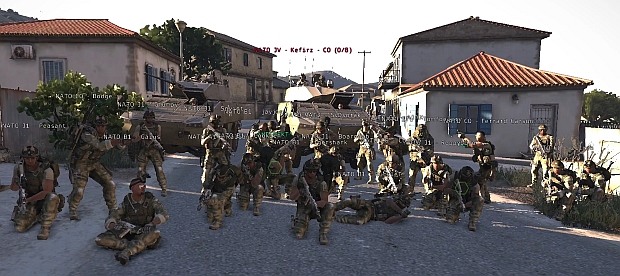A Night With The RPS Arma Community, Folk ARPS
Can a rookie play with Arma veterans?
There was a shot. It was not the sound guns make in Call of Duty or Battlefield. It was more of a sugar stick snapping or stretched bones cracking. Sparks was still running, his back occasionally illuminated by passing bullets. Careful, considered commands still coming over comms. I, however, was not moving. My vision blurred, and I fell. A crack later, and I was no longer in first person – cast into spectator mode by death.
This is how my first mission with Folk ARPS, the Rock, Paper, Shotgun joint Arma 3 outfit, came to an end.
Here is how it began.
Arma [official site] has a reputation for being fiddly to control and intimidating to learn. The assumption goes that if you want to fight alongside a group of other experienced players, then you need to be experienced yourself.
Folk ARPS (FA) is an established and long-running community, and I was interested in sampling some of their operations for myself. Like many people however, I’d never played the vanilla game before. That didn't stop me. I hurried home from work, booted the game and stumbled through 15 minutes of tutorial before jumping onto TeamSpeak to join FA on one of their Tuesday excursions.
FA participate in hand-crafted missions, averaging about 45 minutes in length. There is always a firm goal: eliminate the enemy; or destroy armoured vehicles; or blow up a radio tower. The concentration, coordination and communication required to complete these sessions attracts a large regular crowd to forays twice a week. I hoped that the best way to learn how to play was on-mission, helping contribute to victory.
Joining the FA server was simple, and after tripping into an empty rifleman slot, I plummeted into the action from 12,000 feet. As the last-minute reminders on how to open our parachutes faded from voice comms, our squads dropped through the night onto the mission’s start. Being an utter rookie, I thought that nightvision was only available if you were scoped in on the rifle. This meant I spent our skydive (and most of the mission) in the dark – relying on the silhouettes of landmarks and teammates.
But as we flew through the air, there was only one thing in my sights: a screen-filling, featureless black wall of ground. Hurtling earthward, broad strokes of the landscape came into relief – a few trees here, a fence there and (thankfully) an open field. The approach of the Mediterranean countryside was met with soft ‘flumph’s as our unit opened their chutes. Two button presses later, and I was careening onto the grass with the grace of a camel wearing camo.
Our squads grouped up quickly on landing, finding leaders emerging from hedgerows. There was no need for ‘Thunder/Flash’ codewords to identify friend from foe; we were still miles away from any expected enemy engagements.
FA have tongue-in-cheek lore and jokes born from inter-mission chatter, but once the orders come in when out in the field, banter stops and the commanding officer’s word is god. This adds to the immersion of being in a modern combat environment; who ever heard of a well-trained unit gassing about TV shows in the middle of a stealthy night-mission?
This meant when commands started coming over TeamSpeak, our squad leaders got serious. The instructions were to split up and descend on an occupied town from three sides – and we were driven to success regardless of the odds.
Another immersive aspect of playing with FA is the way death is treated; there’s no five-second respawning mechanic here. As I learned shortly after grouping up with my squad, at least one person had botched their landing and died when they hit the ground. The FA server enables you to be potentially patched-up using a first aid kit if you're wounded, but there’s no cure for faceplanting from thousands of feet. Our unlucky comrade would have to sit in a spectator slot for the rest of the operation.
Learning the consequences of death gave an added edge of excitement to the next 20 minutes as I barrelled after my fireteam's leader, Sparks. We crossed rolling meadows, slithered between tree copses and crouched behind short walls. Starving for stamina, we staggered up hills and took shots at shadows strewn across the blackness where the horizon should have been.
I managed to keep up while fumbling through my controls, trying to find a comfortable position on the keyboard. There were a few confusing moments when I wasn’t sure of which fireteam I belonged to, but on the whole it was really easy to tag along with this unit of experienced troops. Everyone was polite enough to tolerate my flailing, and competent enough to cover my back as I struggled to get up from prone position with embarrassing frequency. Their patience continued even as our squads tightened around the enemy town and the risk of getting shot began to spike.
Manoeuvres across the map were constantly synchronised with other squads, thanks to a sophisticated comms system that enables each leader to speak together, allowing the soldiers serving under them to concentrate on the killing. This is particularly useful when trying to manage 22 people approaching the same square mile of unfriendly territory from several angles.
Our fireteam advanced on the target from the top of a small mound. There were a few lights strewn around the bottom of the hill – the town being barely more than a fortified homestead. Normally, it would be simple to storm such a meagre defence, if not for the armour orbiting the clump of buildings. To my eyes, those vehicles were bulky, metal twins, able to instantly kill any of us who dared to venture too close. Like most of FA’s missions, we were playing against AI rather than human opponents – but they are extremely accurate, even in the dark. Our approach would have to be delicate, even surgical, if we were to avoid being instantly shot.
A friendly squad began their attack from the other side of the town, and we moved from casual overwatch in prone position to charging directly at enemy lines. Thanks to still being blanketed by the night, we remained unseen, sprinting between boulders planted next to a thin road.
Suddenly, we shifted direction, hurrying into a line of trees to face-off against one of the vehicles. We were quickly tasked with neutralising it, and its infantry escort. Maintaining momentum, we broke into an open field, returning fire at distant silhouettes.
A few of our fireteam were struck with hesitation, moving to provide covering fire under the canopy we had just passed through. Sparks, however, pushed through the threats presented by white-hot flying lead. I’d been following him for close to half an hour, and I certainly wasn’t going to stop then. Even with the absence of nightvision, I joined Sparks as we shouldered through a door to oblivion.
There was a shot. Then another. And then I was dead.
There is no in-game punishment for dying; you don’t lose experience, or rank. But you are limited to watching your team try to complete the mission without you – for better, or for worse.
I hadn’t been a key part of the machine required for success, and I witnessed the team assault buildings and blow up armour through bird’s-eye view in green and white hues. By the time ‘Mission Success’ appeared, we had taken a handful of casualties, but the AI had suffered considerably more.
The living celebrated, the dead were commemorated and the server pushed on to a daytime excursion across elevated grassland.
Over the next week and a half I spent with FA, we ran through a variety of scenarios. Although the general framework of missions is consistent, what happens during them has wild variance: the very next mission, we traversed open plains to raid a set of offices, punctuated by a fatal friendly fire incident.
On the Sunday after, 46 of us loaded up in choppers, blew holes in fences and dismantled a radio tower. Later, we held out in a village as it was pounded by attacks on all sides in a lip-biting finale to round off the week’s runs.
Vanilla Arma has a reputation for being difficult to learn, yet somewhat surprisingly, playing with an established community gave me the room to get a feel for its systems and controls while revelling in the immersion of a cooperative combat simulation. The slight (but continuous) pressure of having to keep up with the unit’s collective impetus could be a baptism of fire for some, but I found it refreshing. Even if you die, it gives you the opportunity to watch the others and learn from the way they play – from discovering you can use nightvison even when not scoped in, to the best ways to hide behind hills.
The game’s controls have attracted infamy too, but if desperate you can resist the keyboard and replace it with a 360 controller. This may sound like advocating reliance on an umbilical cord to veterans, but trust me – a “friend” said it works very well, even if you have to battle against the not-quite-zoomed-enough camera.
If you’re curious about experiencing Arma 3 with FA, march over to their site for more information. Joining is really simple: have a read of the details here, and then connect to TeamSpeak during their weekly sessions a little before 19:20 British time on Tuesdays and Sundays. Once you find the actual server using the in-game browser, just sit tight until you get slotted and jump in. You don’t have to install any mods, just the base game.
Thanks to FA for being so accommodating with a rookie like myself.














